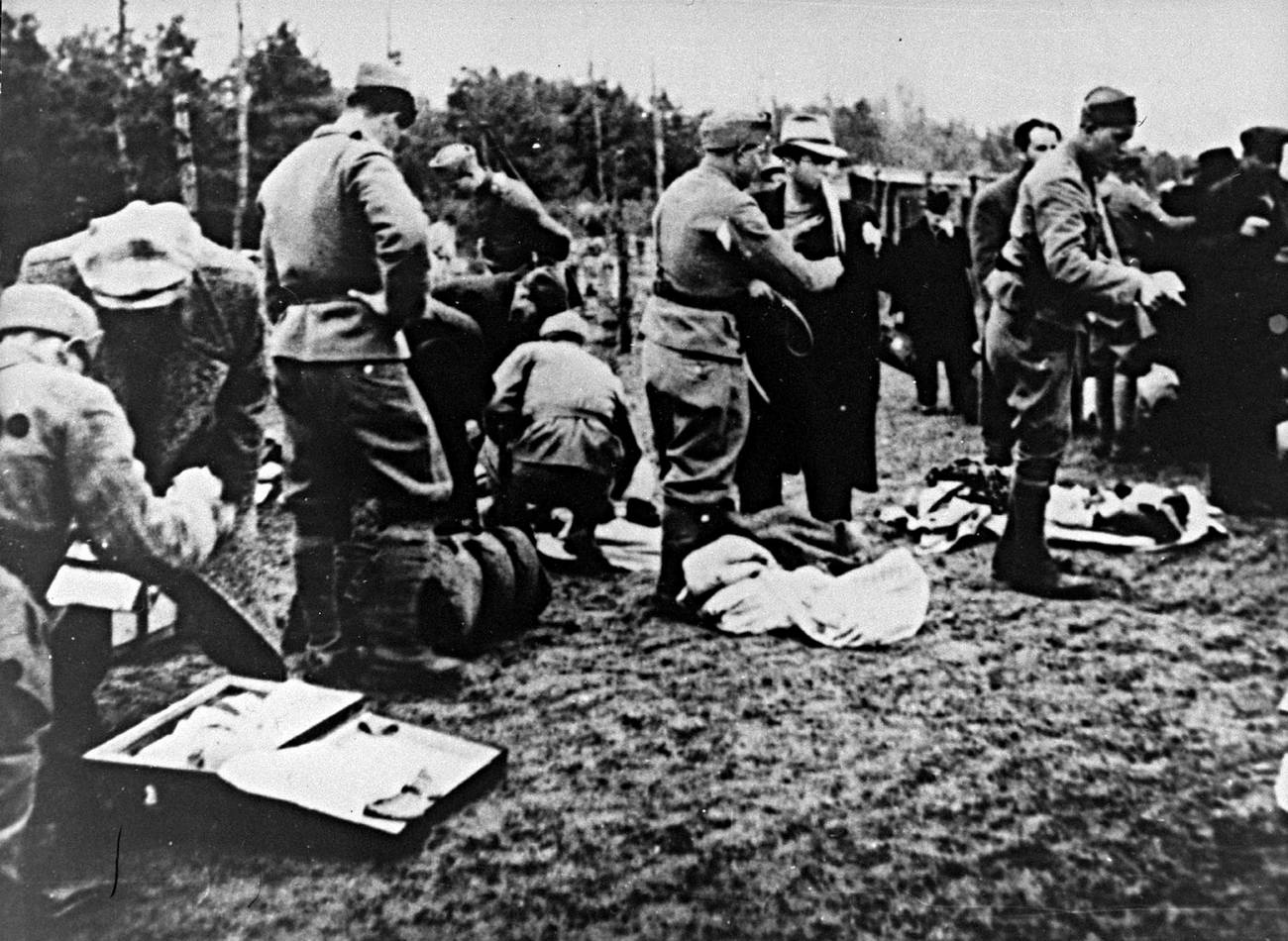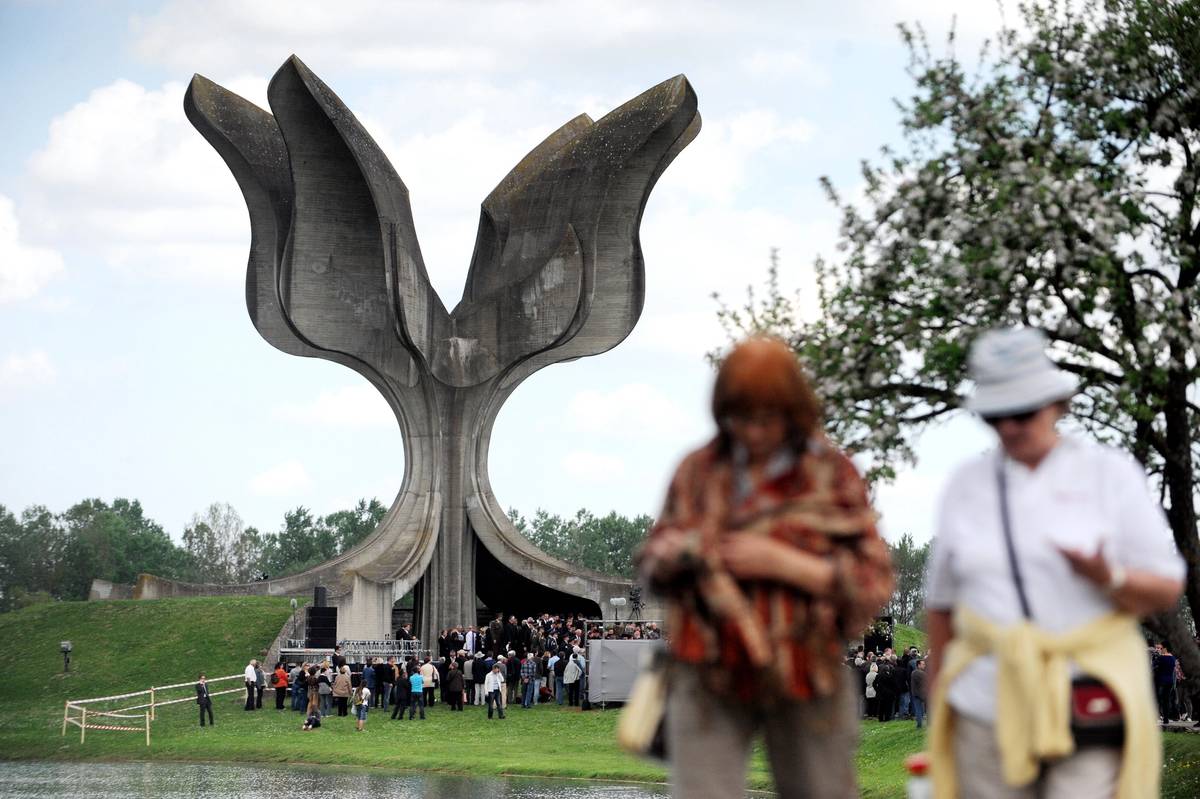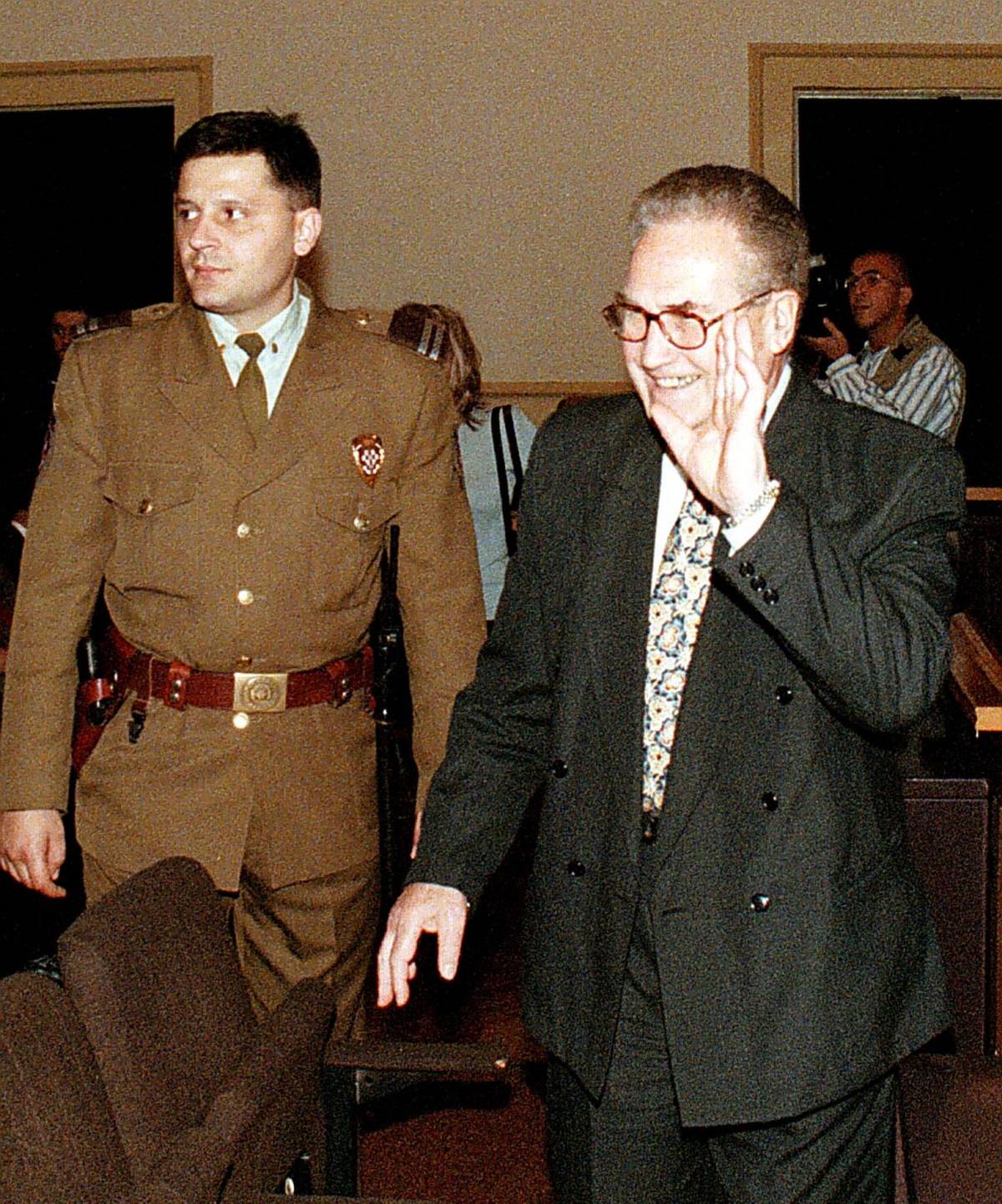 Gen. Andriej Własow w 1944 r. przeprowadza inspekcję mającej walczyć u boku Wehrmachtu Rosyjskiej Armii Radzieckiej (ROA) (akg-images/EAST NEWS / akg-images/EAST NEWS)
Gen. Andriej Własow w 1944 r. przeprowadza inspekcję mającej walczyć u boku Wehrmachtu Rosyjskiej Armii Radzieckiej (ROA) (akg-images/EAST NEWS / akg-images/EAST NEWS)
 Rosyjscy kolaboranci Hitlera. Od wiary w III Rzeszę do wiary w III wojnę światową
Rosyjscy kolaboranci Hitlera. Od wiary w III Rzeszę do wiary w III wojnę światową
Paweł Smoleński
Generał Andriej Własow wierzył, że walcząc u boku Hitlera, nie tylko ocali życie, ale też obali Stalina. Bronisław Kamiński marzył, że po wojnie zostanie wodzem faszystowskiej Rosji.
.
Za cara kształcił się w powszechnej szkole kościelnej, a później dwuletnim seminarium duchownym w Niżnym Nowgorodzie, jakby przeczuwał, iż szansę wyrwania się z wielodzietnej chłopskiej biedy daje jedynie służba w instytucjach związanych z władzą, a tym w przedrewolucyjnej Rosji zdawała się Cerkiew. Lecz w pierwszych miesiącach istnienia państwa bolszewików przynależność do stanu duchownego nie była już kartą atutową, więc Andriusza wstąpił na studia rolnicze.
Edukację przerwała mobilizacja do Armii Czerwonej. W 1920 r. walczył z armią gen. Piotra Nikołajewicza Wrangla, znakomitego dowódcy Białych, który uznawał prawo Polski i Ukrainy do samostanowienia, a w kontrolowanych przez siebie wsiach Donbasu i Krymu rozdawał ziemię chłopom. Gdy Wrangel, świadom spodziewanej klęski, ewakuował swoją armię do Konstantynopola, co zakończyło rosyjską wojnę Białych z Czerwonymi, Andriusza z bolszewickiego rozkazu topił we krwi chłopskie bunty. Dzięki sukcesom w pacyfikacjach zarobił na stanowisko dowódcy kompanii. Z armii nie odszedł, a wojsko szeroko otwierało przed nim wrota kariery.
Andriej Andriejewicz Własow mógł wyglądać dobrego życia. Minęło ćwierć wieku i w moskiewskim więzieniu skończył na stryczku; niektórzy powiadają, że zawiązanym z fortepianowej struny. Łysiejący okularnik stał się znanym na cały świat symbolem kolaboracji oraz rosyjskiego nazizmu. A może sowieckiego? Wszak w kraju, który zdradził, żyli wyłącznie ludzie sowieccy.
Rzeźnik Warszawy
W walce o tron króla rosyjskich kolaborantów miał Własow poważnego konkurenta. To Bronisław Władysławowicz Kamiński, urodzony w białoruskim Witebsku z ojca Polaka i polsko-niemieckiej matki, uważający się za Rosjanina. Herbowy, acz mocno zbiedniały. W 1917 r. studiował na politechnice w Petersburgu, ale już rok później, podczas wojny domowej – krasnoarmiejec–ochotnik. Podczas gdy Własow, świeży bolszewik, w sfingowanych stalinowskich procesach skazywał na śmierć kilkuset oficerów, Kamiński, również członek WKP(b), został inżynierem chemikiem, a potem znalazł się w więzieniu z pospolitego donosu; ponoć krytykował kolektywizację rolnictwa i przymierzał się do szpiegowania na rzecz Niemiec i Polski.
Też skończył marnie, ale akurat z rąk Niemców. Nie jest znana dokładna data jego śmierci. Wiemy, że był schyłek lata 1944 r. lub początek słotnej jesieni. Kamiński jechał do Łodzi z powstańczej Warszawy, gdzie dowodzone przez niego kolaborujące z Niemcami formacje dokonały rzezi ludności cywilnej. SS, której Kamiński był brigadefürherem, sfingowała wypadek lub partyzancką zasadzkę.
Już po wojnie nazistowski zbrodniarz, generał SS Erich von dem Bach-Zelewski, morderca Warszawy podczas powstania, zeznając jako świadek w Norymberdze i podkreślając swoją jakoby wojenną uczciwość, wskazywał osobiste przyczynienie się do śmierci Kamińskiego jako zasługę w wyeliminowaniu potwora oraz sprzeciw wobec polityki Heinricha Himmlera.
Rozkaz niemożliwy do wykonania
Jeszcze przed wybuchem wojny Własow zdążył być doradcą wojskowym w Chinach, co świadczy, iż cieszył się wielkim zaufaniem, i to w czasach, gdy brzmiały jeszcze ostatnie akordy Wielkiej Czystki, kiedy Stalin wytracił swoich najlepszych dowódców, gierojów rewolucji i wojny polsko-sowieckiej. A już po napaści na Polskę został dowódcą garnizonu w okupowanym przez Kreml Przemyślu i awansował do stopnia generała majora. Gdy w czerwcu 1941 r. Niemcy wprowadzili w życie plan Barbarossa, a zagony pancerne Wehrmachtu gnały na wschód przez Białoruś i Ukrainę, utracił przemyską twierdzę, a potem przepadł w obronie Kijowa. Za takie frontowe niepowodzenia Stalin karał srogo, a jednak Własow zachował głowę i zaufanie. Udatnie bronił przedpola Moskwy, gdzie wykazał się wielkim talentem dowódczym i uchronił miasto przed zdobyciem przez hitlerowców. Został za to awansowany i po raz drugi odznaczony Orderem Lenina.
W marcu 1942 r. mianowano Własowa zastępcą dowódcy Frontu Wołchowskiego i dowódcą 2. Armii Uderzeniowej. Walczył niedaleko oblężonego Leningradu. Jego kilkudziesięciotysięczna armia miała ochraniać korytarze służące zaopatrzeniu miasta.
Powierzono mu zadanie niewykonalne. Niemiecka przewaga była absolutna, sowieccy żołnierze głodowali, marli na tyfus i inne choroby zakaźne każdego wojennego frontu, nie mieli broni, a dowództwo żarło się między sobą. Niezmienny rozkaz Stalina brzmiał: ani kroku w tył, walczycie do ostatniego żołnierza, niebawem nadejdzie pomoc. Nie nadeszła, wojsko Własowa znalazło się w okrążeniu.
Tu pojawia się spór między historykami: czy Własow postanowił się wyrwać z okrążenia na rozkaz Kremla, a może była to samowolna decyzja zdesperowanego generała? W ogólnym rachunku nie ma to znaczenia. Sowieckie oddziały nie miały serca do walki, głodni i chorzy żołnierze nie mieli ochoty bić się. Manewr wyrwania się z okrążenia skończyła rzeź; wybito ponad połowę z 70 tysięcy krasnoarmiejców, 2. Armia w zasadzie przestała istnieć.
Własow krył się przez dwa tygodnie, ale w końcu z niedobitkami dostał się do niemieckiej niewoli. Miał 40 lat. Zaś w Berlinie Alfred Rosenberg sformułował niewiele wcześniej koncepcję, by do walki ze Stalinem wykorzystywać rozczarowanie i gniew narodów podległych Sowietom. Rosjanie nadawali się do tego znakomicie.
Wódz Republiki Łokockiej
Kiedy Własow bił się pod Kijowem, Moskwą i Leningradem, w białoruskim miasteczku Łokoć w obwodzie briańskim działała licząca ponad pół miliona mieszkańców tzw. Republika Łokocka, twór udający państwo, niby-zalążek przyszłej Rosji, sojusznika Rzeszy. Jego przywódcą był Konstantin Woskobojnik, nauczyciel, były łagiernik i zesłaniec. W mieście i okolicznych wsiach chętnych do kolaboracji znalazło się dość, łagierników i represjonowanych tzw. kułaków, którzy nadejścia Niemców wyczekiwali z otwartymi ramionami. Gdy do miasta dotarły czołgi Heinza Guderiana, chłopi zaczęli dzielić między sobą ziemię kołchozów, a najeźdźców traktowali jak wyzwolicieli.
Pracujący w miejscowej gorzelni Bronisław Kamiński utworzył za zgodą okupantów oddziały milicji liczące kilkanaście tysięcy ochotników. Zapewniał, że za ich przykładem uda się Niemcom porwać do boju setki tysięcy Rosjan, a rezultatem zwycięstwa będzie wielka faszystowska Rosja, z Kamińskim jako wodzem.
Nie ma pewności, czy Niemcy dali wiarę watażce. A jednak z terenu „Republiki” usunęli swoje oddziały. Bojcy Kamińskiego nieźle radzili sobie z sowiecką partyzantką, choć to właśnie partyzanci zabili Woskobojnika. Tak Kamiński stał się najważniejszą postacią w Łokociu. W 1942 r. nazwał milicjantów Rosyjską Wyzwoleńczą Armią Ludową – RONA.
Po bitwach – stalingradzkiej i na Łuku Kurskim – odwróciły się losy wojny. Pod koniec 1943 r. Niemcy rozpoczęli odwrót z Białorusi. Razem z nimi cofały się oddziały Kamińskiego, zasilone białoruskimi policjantami, sowieckimi jeńcami i zwolnionymi z miejscowych więzień kryminalistami. RONA stała się formacją Waffen SS, a za zasługi dla III Rzeszy Kamiński otrzymał Krzyż Żelazny.
Tylko z Hitlerem obalimy Stalina
Gen. Własow został osadzony w twierdzy Boyen w Giżycku, a potem przewieziony do specjalnego obozu dla najwyższych sowieckich oficerów w ukraińskiej Winnicy. Stamtąd, po konsultacjach z kilkoma współosadzonymi, wysłał do naczelnego dowództwa Wehrmachtu list – deklarację współpracy. Zabrano go do Berlina, gdzie spotykał się z wieloma wziętymi do niewoli sowieckimi oficerami oraz dziennikarzem Mieletijem Zykowem, byłym współpracownikiem Nikołaja Bucharina, więźniem łagrów w Magadanie, armijnym politrukiem i ideologiem kolaboracji z III Rzeszą. Niektórzy twierdzą, że miał żydowskie pochodzenie, więc został aresztowany i zgładzony przez Niemców. Inni – że był kwalifikowanym agentem NKWD podsuniętym Własowowi, po wojnie poszukiwanym przez Sowietów, którzy nigdy go nie znaleźli.
Badacze są zgodni, iż należał do najbardziej zaufanych ludzi Własowa i współtworzył razem z nim inicjatywę powołania Rosyjskiej Armii Wyzwoleńczej – ROA, sformowanej z sowieckich jeńców. Obaj mieli świadomość, że dla wielu z nich wstąpienie do formacji kolaboracyjnej jest jedyną szansą na ocalenie życia; Rosjanie w niemieckich obozach marli na potęgę z głodu i chorób, w sumie grubo ponad 3 mln.
Zaś Niemcom Własow i Zykow tłumaczyli, iż stalinowską Rosję zdołają pokonać tylko Rosjanie, którzy na własnej skórze doświadczyli sowieckiego terroru.
Pomysł armii stworzonej z rosyjskich kolaborantów bardzo spodobał się niemieckim oficerom wywiadu, również z propagandowego punktu widzenia: Rosjanie odbijają swój kraj z rąk komunistów.
Popierał go m.in. Claus von Stauffenberg, przyszły wykonawca nieudanego zamachu na Hitlera.
Własow ruszył na swoiste tournée po ziemiach nadal okupowanych przez III Rzeszę, przemawiał w Smoleńsku (ogłoszono tam publicznie zasady kolaboracji, tzw. deklarację smoleńską napisaną przez generała i Zykowa), Rydze i Pskowie. Niemcy byli pod wrażeniem, z jaką sympatią spotyka się Własow wśród wielu sowieckich jeńców i ludności cywilnej.
Ideę sformowania rosyjskiej armii storpedował osobiście Adolf Hitler. Na wieść o podróżach Własowa dostał szału. Nie wyobrażał sobie, by zwycięstwo nad Sowietami miał zawdzięczać również „rosyjskim podludziom”. Własow znalazł się w areszcie domowym, całkowicie odcięty od wpływów na powstające wojsko. Pił na umór. Jednak pomysłu na rosyjskie oddziały kolaboracyjne ubrane w niemieckie mundury i dowodzone przez Niemców nie zarzucono.
Marny koniec degenerata
Latem 1944 r. RONA Kamińskiego stacjonowała na Śląsku, a dwa pułki SS-mańskiej brygady pod Częstochową. Na wieść o wybuchu powstania warszawskiego Himmler rozkazał, by wyodrębnić z kolaborantów oddział nieżonatych mężczyzn do pacyfikacji zbuntowanego miasta. Rosyjscy zbrodniarze trafili na Ochotę. Ich dowódcą polowym był Iwan Frołow, były sowiecki major i członek partii bolszewickiej, który po wzięciu do niewoli z ochotą przepisał się do kolaboranckiej Narodowo-Socjalistycznej Partii Rosji. Awansowano go do stopnia sturmbannfürhera SS, dwukrotnie otrzymał Krzyż Żelazny, mimo iż w bitwie spisywał się raczej marnie.
Bandyci z RONA byli odpowiedzialni za setki mordów, gwałty i rabunki (razem z nimi pacyfikowały Ochotę m.in. dwa pułki oprawców wywodzących się z sowieckiego Azerbejdżanu). Lecz przerzuceni na pierwszą linię walk w rejonie Alej Jerozolimskich i Nowogrodzkiej zostali zdziesiątkowani przez powstańców. Wycofano ich do Puszczy Kampinoskiej, by blokowali próby przedarcia się do Warszawy AK-owskiej partyzantki. W dwóch bitwach stracili połowę stanu osobowego. Niedobitki zostały wcielone do ROA będącej trzonem świeżo powołanego wojska Komitetu Wyzwolenia Narodów Rosji pod dowództwem Własowa.
Kamiński skończył marnie w wyniku niemieckiego spisku, mimo że uważał się za bezpośrednio podporządkowanego Himmlerowi i stąd czerpał przekonanie, że to on, a nie Własow, będzie trzymać stery przyszłej faszystowskiej Rosji.
Gen. von dem Bach-Zelewski – choć sam był zbrodniarzem – uważał Kamińskiego za wyjątkowego degenerata i otwarcie cieszył się z jego śmierci.
Frołow przeżył powstanie i Puszczę Kampinoską. Wykładał taktykę wojskową w berlińskiej szkole ROA. Został złapany przez zachodnich aliantów i wydany Stalinowi. Skończył pod ścianą w grudniu 1945 r.
Jak podlizać się zwycięzcy
Do pomysłu, by kolaboracyjne jednostki rosyjskie skupić pod wojskowym i politycznym dowództwem Andrieja Własowa, Niemcy wrócili pod koniec 1944 r. Himmler zaaprobował powstanie Komitetu Wyzwolenia Narodów Rosji i nową mobilizację prowadzoną wśród jeńców i rosyjskich robotników przymusowych.
Lecz Własow nigdy nie zdobył pełnego zaufania Niemców. ROA rzucono do walki dopiero w marcu 1945 r. nad Odrę w rejonie Kostrzyna, a później pod Budziszyn. Rany leczyli potem w Czechach, pod Karlowymi Warami.
Gdy wybrzmiewały ostatnie akordy II wojny światowej, Własow miał świadomość, że trzyma z przegranymi. Ale też wiedział, że wielu Rosjan bije się zaciekle u niemieckiego boku, wiedząc, że jeśli popadną w sowiecką niewolę, czeka ich i ich rodziny los gorszy od śmierci.
Generał łudził się perspektywą, że niebawem odwrócą się sojusze i armie zachodnich aliantów, wsparte sojusznikami ze Wschodu, pójdą na Moskwę. Podobną wiarę w III wojnę światową żywili Polacy.
Lecz Polacy w znakomitej większości nie musieli w związku z wypatrywaną wojną szyć sobie nowych szatek. Własow – zbrodniarz w sowieckich i niemieckich kamaszach – musiał. Zresztą wszyscy, którym palił się wówczas grunt pod nogami, szukali, jak tu podlizać się zwycięzcy. Polscy antysemici i kolaboranci nazistów z Brygady Świętokrzyskiej bili się o obóz koncentracyjny Holleischen (Holýšov), gdzie wyzwolili garść żydowskich więźniarek. Własowcy z kolei pomogli powstańcom w Pradze, którzy samodzielnie nigdy nie wyzwoliliby miasta. Walczyli bardziej ofiarnie niż żołnierze Armii Czerwonej, poległo ich kilka setek.
Polskim sojusznikom nazistów udało się do tego stopnia, że mają w Monachium ozdobną płytę, składał przy niej kwiaty Mateusz Morawiecki pełniący funkcję premiera. Rosjanie nie mieli tyle szczęścia. Dowódcy i jeńcy, również z innych formacji kolaboracyjnych wywodzących się z narodów Związku Sowieckiego, zostali wydani Stalinowi. Proces wyższych oficerów Rosyjskiej Armii Wyzwoleńczej trwał mniej niż dzień. Wszystkich powieszono.
***
Różne motywy pomocników Hitlera
Wśród sowieckich kolaborantów III Rzeszy było kilku generałów i pułkowników Armii Czerwonej, wszyscy zasłużeni dla bolszewików już podczas rewolucji październikowej i wojny domowej. Formacje kolaboracyjne składały się z sowieckich jeńców wojennych (ok. 700 tys.), ochotników zamieszkałych na podbitych terytoriach, przedstawicieli narodów, np. Białorusinów, Ukraińców, Ormian, Gruzinów, Azerów, Czerkiesów, Kałmuków czy Tatarów, które wierzyły, że po upadku Stalina odzyskają niepodległość lub zemszczą się za doznane krzywdy, oraz tzw. hiwisów, czyli – prócz jeńców – cywilnych pracowników niemieckiej armii i administracji. Ważną grupą kolaborantów byli Kozacy.
Sowieccy kolaboranci Hitlera zostali wydani Stalinowi. Czekały ich procesy z wyrokami śmierci, długoletnie łagry lub zesłanie wraz z krewnymi. Szubienicy uniknęli Ukraińcy z SS Galizien, m.in. dzięki interwencji gen. Władysława Andersa, który doskonale rozumiał plątaninę losów ukraińskich niepodległościowców. Ostatni dowódca jednostki gen. Pawło Szandruk został nawet odznaczony krzyżem Virtuti Militari za bohaterstwo podczas kampanii wrześniowej, a kilkuset byłych ukraińskich SS-manów założyło mundury żołnierzy 2. Korpusu Polskiego. Oraz Litwini, Łotysze i Estończycy.
Litwini wypowiedzieli Niemcom posłuszeństwo, gdy postanowiono zmienić zarówno dowództwo, jak i symbolikę oddziałów. Część, w tym głównodowodzący gen. Povilas Plechavicius, trafiła do obozów koncentracyjnych i na przymusowe roboty. Część poszła do lasu, tworząc antysowiecką partyzantkę. Łotysze i Estończycy trwali przy Niemcach do końca wojny, lecz nie zostali wydani Sowietom przez zachodnich aliantów. Choć trybunał w Norymberdze uznał Waffen SS za organizację przestępczą, to w 1950 r. Stany Zjednoczone stwierdziły, że SS-mani z Łotwy i z Estonii nie walczyli przeciwko USA, i zezwoliły żołnierzom tych jednostek ubiegać się o prawo pobytu w Ameryce.
Zawartość publikowanych artykułów i materiałów nie reprezentuje poglądów ani opinii Reunion’68,
ani też webmastera Blogu Reunion’68, chyba ze jest to wyraźnie zaznaczone.
Twoje uwagi, linki, własne artykuły lub wiadomości prześlij na adres:
webmaster@reunion68.com










